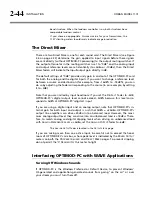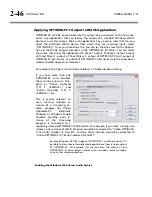
OPTIMOD-PC
INSTALLATION
2-31
Achieving correct on-air loudness and proper operation of the 1101’s
loudness meter requires you to align the transmission system following
the 1101 so that 0.0 dBfs at the 1101’s output corresponds to 100% peak
modulation of the transmitter. When the R
EFERENCE
S
OURCE
=
D
IGITAL
O
UTPUT
1, using the 1101’s D
IGITAL
1
O
UTPUT
control to set the gain be-
tween the 1101 and the transmitter will not produce correct loudness
controller and loudness meter calibration and on-air loudness because
this control only sets the maximum peak level while attempting to main-
tain the average modulation constant when adjusted. It does this by driv-
ing the look-ahead limiter 1 dB harder for every 1 dB that the 2.0
O
UTPUT
L
EVEL
is turned down.
E)
Test modulation with program material to determine the overshoot in your
transmission system.
a)
Disconnect the audio oscillator from the 1101’s active output and reconnect
your normal program source.
b)
Recall the
TVA
5B
G
EN
P
URPOSE
preset
.
c)
Apply typical program material to the 1101’s input. Verify that the
L
IMITER
GR
meters
are indicating gain reduction on peaks, which ensures that the
1101 is producing 100% peak modulation on program material.
d)
Measure your transmitter’s peak modulation. If this exceeds 100%, turn
down the 1101’s
DO1
100%
control until the modulation of peaks of
frequent recurrence is constrained to 100% deviation.
Turning down the DO1
100%
control reduces the peak modulation
without significantly affecting the average modulation. Hence, using this
technique keeps the 1101’s L
OUDNESS
L
EVEL
meter correctly calibrated and
provides correct on-air loudness.
F)
Check loudness with respect to other stations in your market and correct your
average modulation if necessary.
You have just adjusted on-air loudness to match the loudness that an Op-
timod-TV 8382 would produce when set up normally. However, because
there is no standard value for the average modulation in analog TV
transmission, the loudness of your analog transmission might be different
from other stations in your market. If this is so, match the 1101’s loudness
to the other stations by adjusting the
D
IALNORM
control in the on-air pre-
set. This control is located in the
L
ESS
-M
ORE
tab. For example, changing
D
IALNORM
from –17 dB to –15 dB makes the transmission 2 dB louder. Ad-
justing
D
IALNORM
is the
only
correct way to adjust on-air loudness after
the system has been calibrated according to steps (D) and (E) above; this
technique will retain correct calibration of the 1101’s loudness level me-
ter and loudness controller.
Note that increasing the loudness in this way will increase the likelihood
that the 1101’s look-ahead limiter will create audible “pumping” or
“gulping” artifacts on program material that is rich in high frequencies
because the look-ahead limiter is operating on a preemphasized signal
and turning up D
IALNORM
drives the look-ahead limiter harder. If you hear
such artifacts, we recommend that you use a 5-Band TVA preset if you
are not doing so already. This allows you to use the Band 5 compres-
Summary of Contents for Optimod-PC 1101
Page 4: ......
Page 14: ......
Page 121: ...OPTIMOD PC OPERATION 3 1 Section 3 Operation Figure 3 1 The OPTIMOD PC Control Application...
Page 192: ...3 72 OPERATION ORBAN MODEL 1101...
Page 204: ......
Page 210: ......
Page 212: ...5 2 UNINSTALLATION ORBAN MODEL 1101...
Page 236: ......
















































